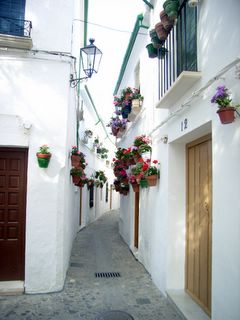droopy update/priego de cordoba: part I
First an update on the little Beebs: he is much, much better today, and I am fairly convinced his ears aren't broken after all. The swelling is almost completely gone in his right ear and about 80% down in the left ear, which was the worse of the two. But more importantly, he can perk up his ears today, which I don't think would be possible if they were broken. The fever is also down. My gameplan is to take him back to the vet in the village Monday as scheduled, but if he insists the ears are broken and wants to operate, I will take the "no longer Droopy" to our regular vet on the coast for a second opinion. I am thinking that my original feeling, that he got into a bee's nest on the goat trail (which is alive with all sorts of stingy things) or had an allergic reaction to some other bite or whatnot, was correct. Still glad I took him to the vet when I did, however, because he clearly needed the shots and meds he is taking. Okay, now that I am considerably calmer than yesterday, I will fill you in on the trip to Priego de Cordoba. The drive there through the mountains was fantastic. As I mentioned previously, there are just olive trees for miles and miles. As I have lamented in earlier posts about the continued development to the campo around the village, I found these landscapes amazingly refreshing.

As M.A. and I drove through the countryside, car windows open, the smell of olive presses churning out our beloved aceite wafted in the breeze. I do love a roadtrip. :-)

We stopped at a cafe for lunch, and I had to take a photo of these lilacs because their smell is one of my favorites, and we just don't have them in our part of Spain. In this part of the province of Cordoba, known as la Subbetica, I also admired the style of farmhouse, much different than the cortijos around the village, and perhaps evidence of wealth that arrived in these parts long before it reached our part of Andalucia. Those that dot the valleys around the village here are much smaller, usually two or three rooms and all single story. The farmhouses closer to Priego were all at least two-story structures and with many, many more rooms, anywhere from four- to eight-bedroom houses. The architectural style was still simple, which appeals to me, but clearly more space to spread out. (Note to self to check real estate prices for la Subbetica.) We arrived in Priego de Cordoba in the middle of siesta. Parking was a bit difficult because one of the main town squares is currently dug up and under construction. True to Andalucian form, there were no notices of this, nor detour signs redirecting traffic. So we backtracked as M.A. tried to approach the center from the other side of town. This time we were waved off by a man working for the ayuntomiento, who told us we could not drive down what was clearly a two-way street. I explained we were looking for parking, and he told us to go back to the Mercadona supermarket and park there. We had passed this market on our journey, but there was a large sign indicating the garage was only for patrons of Mercadona. I questioned the man about this, but he assured me all would be copacetic. We trudged along with our bags, through the dug-up plaza, to the hostal where M.A. usually stays on her visits to Priego. After picking up the key, we went through the interior courtyard to the lift up to our third-floor room. Quickly dropped off the bags as M.A. was craving a drink. A gin and tonic later, we were off exploring. First, we wandered through the old Arab quarter, with streets so narrow they made our c/ San Antonio look like a major thoroughfare.


My favorite rincon in the Arab quarter. Surrounding much of the Arab quarter is a promenade that looks over the countryside, and then opens into this beautiful park, full of shade trees and children playing.


After our stroll, we were decidedly hungry, so we stopped at a restaurant in the plaza just a stone's throw from la Iglesia de la Asuncion, whose chapel is one of the best examples of barroco cordobes architecture (more on this in part II). We studied the menu (which was all in Spanish; no English and German translation pages, which pleased me greatly), and agreed to share the cold three-salad combo as a starter. M.A. chose a chicken dish and I pork al ajillo for our main course. The waiter quickly brought us a pitcher of their house red, a basket full of five different breads to sample, and a plate of the most amazing olives. Frankly, we would have been content to just fill up on these! The salad arrived with more delights: mixed roasted peppers, sauteed swiss chard and carrots spiced with cumin, and an eggplant and garlic puree, telling of the continued Moorish influence in this part of Spain. We found the same when our main courses arrived. My pork with garlic also included a sauce of raisins, and M.A.'s chicken was done with cinnamon, tumeric, and fennel---dishes I would more expect to find on a menu in Morocco than certainly in our village. I was completely full by postre time, but M.A. had creme andaluz, and we both had a brandy to cap off a fantastic meal. We slowly walked back to the hostal through the silent streets and quickly drifted into a deep slumber. A lovely, lovely day. hasta pronto, mylifeinspain





0 Comments:
Post a Comment
<< Home